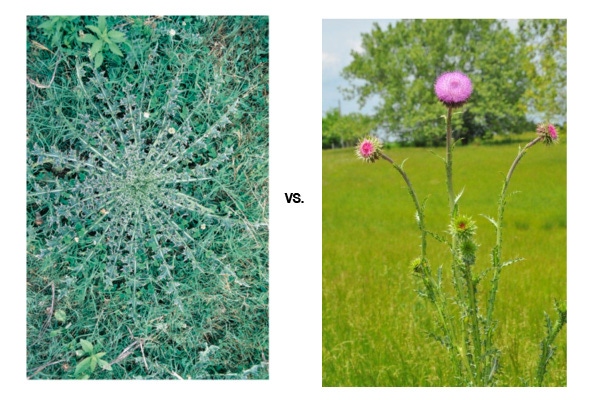Which Thistle Do You Spray For Best Return On Investment?
You’ll be money ahead to look for thistles this fall, spray the rosettes, and prevent that purple-dotted picture in the spring.
December 27, 2013

You probably know.
Weed scientists recommend spraying when thistles are in the rosette (early, flat-growing) stage.
But it’s just human nature to think about spraying thistles when they’re obvious – bolted, budded and blooming in the spring and summer. And GrazonNext® HL herbicide at the maximum labeled rate has been effective on bolted thistles, say the Range & Pasture experts at Dow AgroSciences.
But you’ll be money ahead, they say, to look for thistles this fall, spray the rosettes, and prevent that purple-dotted picture in the spring.
If not now, you can do that soon.
For several reasons, spraying rosettes delivers maximum “bang for the buck.”
Thistles compete with grass for sunlight, moisture and soil nutrients. You can grow more grass or bigger, better thistles.
Those stickers on the plant discourage cattle from grazing near thistles. According to some studies, 30 percent to 60 percent of your forage may go untouched because cows don’t want to graze among them.
By the time you see a thistle in bloom, it has done much of its competitive damage. And it’s putting on seed for more thistles next year.
But, if you control a thistle in the rosette stage, it disappears before it has taken much from you. You save lost grazing, and you stop adding more thistle seed to the soil.
Spray in fall or spring
Biennial thistles – musk, bull and plumeless – are all easy to control in the rosette stage. You can spray in the fall or early spring. Many cattle producers find they have more time in the fall, and it may be easier to get a custom applicator then.
As a rule of thumb, you want the high temperature to be at least 55 F the day you spray and for a couple of days afterward. Use GrazonNext HL herbicide at the labeled rate of 1.5 pints per acre. That rate will control the rosettes, plus it will provide soil residual activity to control thistles and some winter annuals that may germinate after spraying. (Chickweed has been an exception.)
A fall treatment typically gives your grass a head-start in the spring, but don’t expect the soil residual activity to last into the following summer. If you want to control horsenettle or other weeds that emerge in the summer, plan to spray again.
If you have lots of thistle seed in the soil, you may need to spray rosettes two or three years in a row. And, as long as the wind blows or birds fly, expect a few thistle seeds to find their way into your pasture again. Stay watchful and try to catch any infestation early. Spot-spraying those early, small infestations is another way to maximize ROI.
Label precautions apply to forage treated with GrazonNext HL and to manure from animals that have consumed treated forage within the last three days. Consult the label for full details.
®Trademark of Dow AgroSciences LLC
GrazonNext HL is not registered for sale or use in all states. Contact your state pesticide regulatory agency to determine if a product is registered for sale or use in your state. Always read and follow label directions.
Other helpful resources:
Winter Treatment To Help You Get A Jump On Spring Brush Control
Pasture Clover: When Do You Sacrifice Clover For Weeed Management?
6 Tiips For Cost-Effective Weed Control
About the Author(s)
You May Also Like


.png?width=300&auto=webp&quality=80&disable=upscale)
